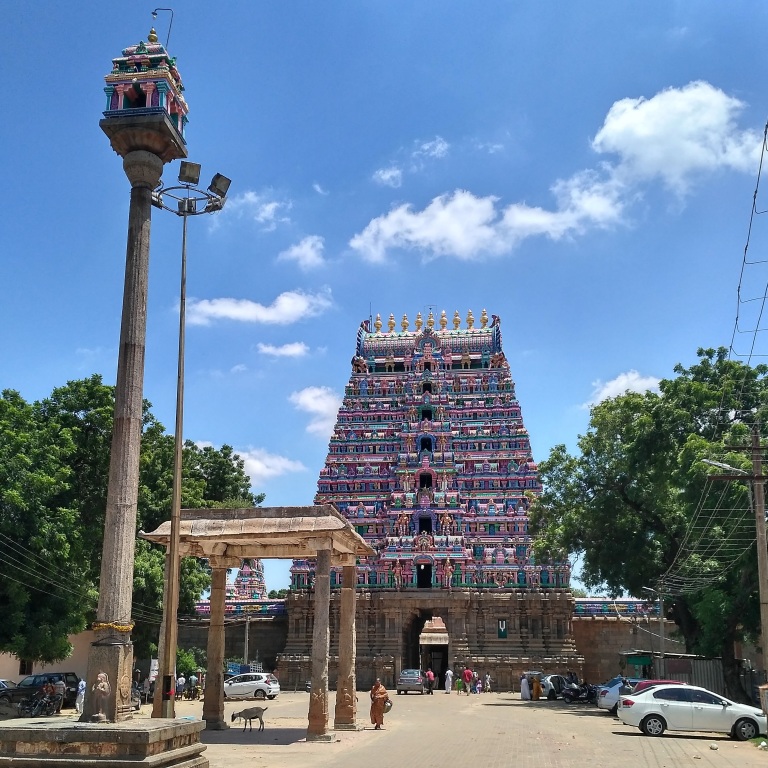Srimushnam Bhu Varaha Swamy Temple, Cuddalore

Address
Srimushnam Bhu Varaha Swamy Temple, Srimushnam, Virudhachalam taluk, Cuddalore District – 608 703 Phone: +91 4144 245 090 Mobile: +91 94423 78303
Deity
Varaha (Bhu Varaha Swamy) AMMAN: Lakshmi (Ambujavalli Thayar)
Introduction:
- Located in Srimushnam, Cuddalore district, Tamil Nadu, this temple is dedicated to Lord Vishnu in his boar-avatar (Varaha Avathaar) form, known as Bhu Varaha Swamy. His consort is Ambujavalli Thayar.
- The temple features Dravidian-style architecture and has historical significance, with contributions from the Medieval Cholas (10th century) and expansions by the Thanjavur Nayak king, Achuthappa Nayak.
- Surrounded by a granite wall enclosing the shrines and temple tanks, the temple has a seven-tiered Rajagopuram (gateway tower).
- Srimushnam is one of the eight Swayambu Vyaktha Kshetrams of Vishnu, where the deity is believed to have manifested on its own.
- The temple is renowned for symbolizing Hindu-Muslim unity, with Muslims providing the flag for the temple chariot and offering prayers to Allah in the mosques after receiving offerings from the temple.
Puranic Significance:
- The temple dates back to the medieval Chola period, with inscriptions from the 11th century indicating its existence. Contributions from the Cholas, Vijayanagara kings, and Nayaks are notable, including the construction of the sixteen-pillared Purushasuktha Mandapa by Achuthappa Nayak.
- Varaha Avathaar: The temple is associated with the Varaha avatar of Vishnu, where Lord Vishnu, in the form of a boar, rescued the earth-goddess Bhudevi from the demon Hiranyaksha.
- The temple tank, Nithya Pushkarani, is believed to have been formed from the sweat of the demon, and the deity faces south towards the demon in respect to his dying wish.
- Lord Vishnu is believed to reside in this place in three forms: as the Ashwatha tree, the Nithya Pushkarani, and Bhu Varaha Swamy.
Beliefs:
- Worshipping Lord Varaha Perumal at this temple is believed to bless devotees with eloquence, stable wealth, health, children, and longevity.
- It is a popular site for those facing adverse effects of Rahu and Ketu. People also perform pujas for new vehicles or vehicles involved in accidents.
- The temple is known as a Prarthana Sthalam for childless couples and unmarried individuals. Women take a bath in Nithya Pushkarani, circle the Arasa tree 12 times, and perform specific rituals to be blessed with children.
- Special offerings include Korai Kizhangu as prasadam to the Lord.
Special Features:
- The temple has two gopurams and two precincts enclosed within large granite walls. The seven-tiered western tower serves as the main entrance, while the five-tiered eastern tower opens only during Vaikunta Ekadasi.
- An 80-foot monolith pillar with Garuda on top stands outside the temple.
- The central shrine houses Varaha (Bhu Varahaswami) depicted as a 2-foot Saligrama stone image with a boar-faced Varaha in a victorious posture.
- The temple is one of the eight Swayambu Vyaktha Kshetrams of Vishnu in India, along with Srirangam, Tirupathi, Vanamamalai, Salagramam, Pushkaram, Naimisaranya, and Badrikashramam.
Festivals:
- The temple conducts six daily rituals and celebrates three yearly festivals. The most prominent is the Chariot festival in Vaikasi (April–May), which emphasizes Hindu-Muslim unity.
- Other festivals include Sri Jayanti Utsavam during Aavani, Navaratri, Vijayadasami, Deepavali, and Makara Sankranti.
- The temple allows Muslims to worship until the Ardha Mandapam, showcasing its inclusive nature.
This temple is a significant pilgrimage destination for both devotees of Lord Vishnu and those seeking blessings for various aspects of life.
Century/Period/Age
1000-2000 years old
Managed By
Hindu Religious and Charitable Endowments Department
Nearest Bus Station
Srimushnam
Nearest Railway Station
Virudhachalam
Nearest Airport
Puducherry






